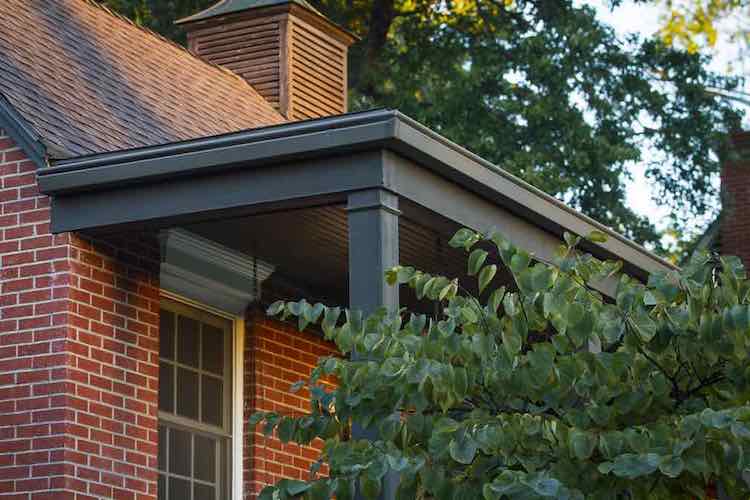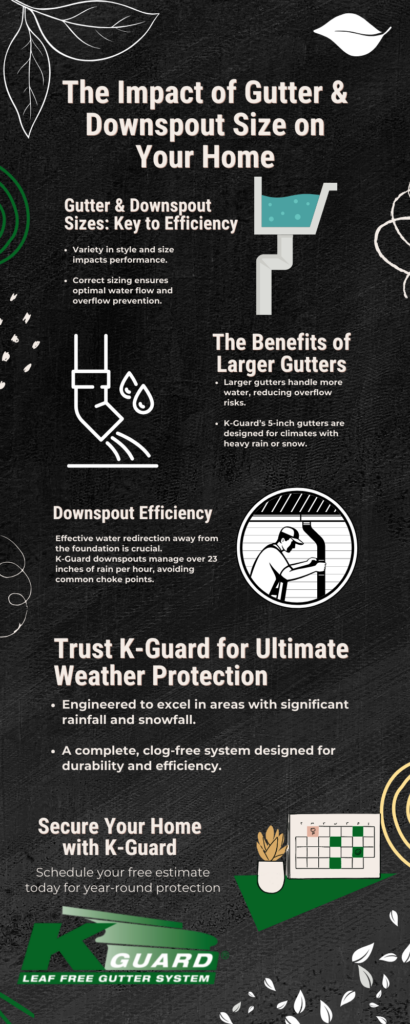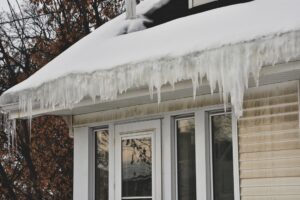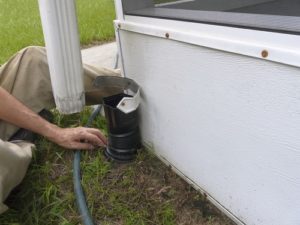
Roofs are without a doubt a crucial component of a home. They function to cover us, keep us safe from weather conditions, birds, and other pests, and provide a barrier from harsh temperatures. Without one, we definitely wouldn’t feel as safe in our homes as we currently do.
Not only is the main function of a roof important, but did you know that the design and the pitch of the roof are important too, especially when it comes to which type of gutter to install? Roofs come in different designs and pitches and they all play a role in how a gutter system functions.
Keep reading to learn what type of gutters work with your roof as we discuss different roof designs and pitches so you can make an informed decision as to which type of gutter system to install.
Roof Designs
Flat/Low-Slope Roof
A flat or low-slope roof is just as the name implies; a roof that is flatter on the surface with a very minor slope. Most flat roof slopes are between ¼-½” which allows some water to drain off of the roof, but the slope isn’t enough to keep up with heavy rains and snow. While they are a more modern design that’s rising in popularity, they do pose some risks of leaks if the home builder doesn’t use quality materials.
Most gutter systems will work to collect and drain water away from a flat or low-slope roof. However, drainage issues are usually a result of the low slope rather than the actual gutter system.
Gable Roof
As one of the most common roof designs in America, gable roofs have two sides that slope and meet in the middle at what’s called a ridge and form a triangle that extends from the home’s roof. They’re able to drain more water than a flat or low-slope roof, however, they’re usually more prone to damage from high winds when compared to other roof designs.
Gable roofs work with most gutter systems, but because of the ridges and extensions of a gable, the gutter system will require careful and precise planning to ensure drainage issues don’t occur as a result of their more complicated design.
Hip Roof
Unlike gable and flat roofs, the sides of a hip roof are angled to slope down to the walls of the home. Hip roofs can either be shaped like a pyramid, triangle or trapezoid depending on the design. Hip roofs are easily identifiable because they don’t have any gables and have more of a slope than a flat roof. Advantages include more wind protection and how well they can move and direct precipitation off of the roof. However, they are a little more pricey and can leak more than other roof styles.
You can install virtually any type of gutter system on a hip roof, however, the gutter system must be used around the entire roof, not just sections.
Metal Roof
Nothing can beat the durability and lifespan of a metal roof if it’s installed properly. Not only can they hold up to high wind speeds, but they also have a lifespan of nearly double that of other roofing materials. With that being said, they are pricey and it can be difficult to find a perfect match to the metal used if it needs any repairs.
While metal roofs are extremely durable, they aren’t the best when it comes to working with a gutter system. Because water moves so quickly down a metal roof due to lack of friction, water makes its way down the roof faster than most gutter systems can collect the water. You’ll have to be very careful when selecting the right gutter system when it comes to your metal roof.
Types of gutters
K-Style Gutters

K-style gutters are highly popular due to their ease of installation for DIY enthusiasts and their decorative appearance, reminiscent of crown molding. These gutters are typically available in 5-inch to 6-inch widths and are often paired with rectangular downspouts. Their design includes a flat back, allowing for straightforward installation by nailing them directly to the fascia boards. However, a notable drawback of K-style gutters is their maintenance challenge. The inner angles of these gutters tend to accumulate debris, which can lead to rotting issues.
Half-round Gutters
Half-round gutters are characterized by their semicircular shape and a curved lip, a design that pairs well with round downspouts. Similar to K-style gutters, they are available in widths of 5 inches to 6 inches. These gutters were a common choice for homes constructed before 1960 and possess a classic, traditional aesthetic. Consequently, they are particularly suitable for historic homes and those with brick exteriors. In some cases, especially for historical homes or in older neighborhoods, local regulations may mandate the use of this style of gutter.
Box-Style Gutters
Box-style gutters are most commonly seen on commercial and industrial buildings, but they have also been adopted in residential settings for an industrial look. These gutters are significantly larger, designed to manage high volumes of rainwater, which makes them a great fit for houses with large roofs. They are typically available in widths of 7 inches and 8 inches, though some can be as wide as 10 inches.
Differing from K-style and half-round gutters, box-style gutters are not installed along the edge of the roof. They feature a tall back section that fits under the roof shingles. As a result, they need to be integrated during the construction of the home, rather than added afterward.
Fascia Gutters
Roof Pitch
While roof design can be an important factor when choosing the right gutter system, roof pitch also plays a role. The pitch of a roof refers to how steep the design is and how fast water can drain from the roof due to the steepness of the pitch. Roofs are categorized by having a low-pitch or a fast-pitch, depending on the two numbers that make a ratio.
A roof pitch ratio is calculated using the vertical length of the roof (the first number) and the horizontal length of the roof (the second number). The higher the vertical length of the roof, the greater the pitch of the roof. As an example, the average gable roof pitch is around 4:12.
Roof pitch matters when it comes to selecting the right gutter system for your roof because it can help you determine which gutter system is best based on how fast the roof pitch can move water. Lower slopes like a flat roof will move water much slower than a metal roof.
Determining the type of gutter system that will work best with your home depends on your roof’s pitch and design. Whether your home has a flat/low-slope, gable, hip, or metal roof, it should always have a quality gutter system installed to ensure the roof is kept dry and water drains properly.
Luckily, the K-Guard Leaf Free Gutter System works on every type of home whether you have a low-pitched or steep-pitched roof. K-Guard is the perfect solution to keep your gutters clean and your home protected from water damage regardless of roof pitch.
Our gutter system is a complete system that has three components: a curved hood, gutter, and oversized downspouts. Our curved hood allows rain, meltwater, and all other forms of precipitation to flow from the roof and into the gutter while eliminating the possibility for debris to enter the system, therefore preventing clogs. Our gutters and downspouts are oversized to allow for more rainfall, ice melt, and other forms of precipitation to flow at a much faster rate than traditional gutter systems allow.
If your home needs a new gutter system or if you need to replace an existing one, request a free estimate today. We proudly install the K-Guard Gutter System across the state of Colorado including, but not limited to, the following locations: Denver, Colorado Springs, Littleton, Centennial, Aurora, Boulder, and Fort Collins.
We look forward to helping you protect your home by installing our quality gutter system regardless of your home’s roof design or pitch!



